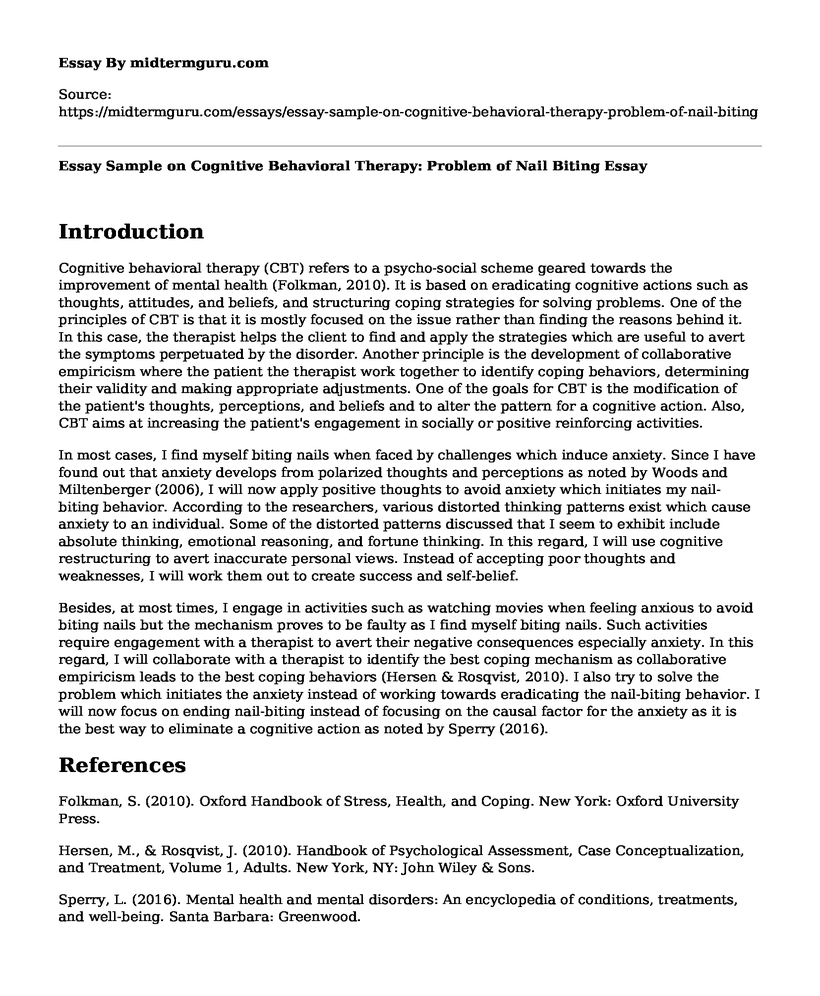Introduction
Cognitive behavioral therapy (CBT) refers to a psycho-social scheme geared towards the improvement of mental health (Folkman, 2010). It is based on eradicating cognitive actions such as thoughts, attitudes, and beliefs, and structuring coping strategies for solving problems. One of the principles of CBT is that it is mostly focused on the issue rather than finding the reasons behind it. In this case, the therapist helps the client to find and apply the strategies which are useful to avert the symptoms perpetuated by the disorder. Another principle is the development of collaborative empiricism where the patient the therapist work together to identify coping behaviors, determining their validity and making appropriate adjustments. One of the goals for CBT is the modification of the patient's thoughts, perceptions, and beliefs and to alter the pattern for a cognitive action. Also, CBT aims at increasing the patient's engagement in socially or positive reinforcing activities.
In most cases, I find myself biting nails when faced by challenges which induce anxiety. Since I have found out that anxiety develops from polarized thoughts and perceptions as noted by Woods and Miltenberger (2006), I will now apply positive thoughts to avoid anxiety which initiates my nail-biting behavior. According to the researchers, various distorted thinking patterns exist which cause anxiety to an individual. Some of the distorted patterns discussed that I seem to exhibit include absolute thinking, emotional reasoning, and fortune thinking. In this regard, I will use cognitive restructuring to avert inaccurate personal views. Instead of accepting poor thoughts and weaknesses, I will work them out to create success and self-belief.
Besides, at most times, I engage in activities such as watching movies when feeling anxious to avoid biting nails but the mechanism proves to be faulty as I find myself biting nails. Such activities require engagement with a therapist to avert their negative consequences especially anxiety. In this regard, I will collaborate with a therapist to identify the best coping mechanism as collaborative empiricism leads to the best coping behaviors (Hersen & Rosqvist, 2010). I also try to solve the problem which initiates the anxiety instead of working towards eradicating the nail-biting behavior. I will now focus on ending nail-biting instead of focusing on the causal factor for the anxiety as it is the best way to eliminate a cognitive action as noted by Sperry (2016).
References
Folkman, S. (2010). Oxford Handbook of Stress, Health, and Coping. New York: Oxford University Press.
Hersen, M., & Rosqvist, J. (2010). Handbook of Psychological Assessment, Case Conceptualization, and Treatment, Volume 1, Adults. New York, NY: John Wiley & Sons.
Sperry, L. (2016). Mental health and mental disorders: An encyclopedia of conditions, treatments, and well-being. Santa Barbara: Greenwood.
Woods, D. W., & Miltenberger, R. G. (2006). Tic Disorders, Trichotillomania, and Other Repetitive Behavior Disorders: Behavioral Approaches to Analysis and Treatment.
Cite this page
Essay Sample on Cognitive Behavioral Therapy: Problem of Nail Biting. (2022, Oct 04). Retrieved from https://midtermguru.com/essays/essay-sample-on-cognitive-behavioral-therapy-problem-of-nail-biting
If you are the original author of this essay and no longer wish to have it published on the midtermguru.com website, please click below to request its removal:
- A Trip to Vietnam Helped This Son Make Peace With His Dad's Death - Article Analysis
- Paper Example on Crisis and Trauma Counseling on Domestic Violence
- Essay Sample on Antidepressant in Children and Adolescent
- The Nature of Psychopathic Personality Revealed by Peter and Val - Essay Sample
- Cognitive Aging: Developmental Processes Across Adulthood - Resesarch Paper
- The Proteostasis Network: Preserving Cellular Balance in Aging - Essay Sample
- Nature and Nurture: The Uniquely Human Combination - Essay Sample







